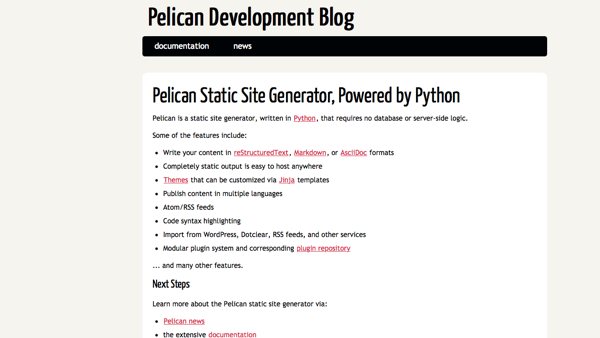6 Static Blog Generators That Aren’t Jekyll
Key Takeaways
- Middleman, Hugo, Hexo, Pelican, Metalsmith, and Octopress are viable alternatives to Jekyll for static blog generation, each offering unique features and benefits. Middleman is more flexible, Hugo is renowned for its speed, Hexo is JavaScript-based, Pelican is Python-based, Metalsmith uses a unique plugin-based architecture, and Octopress offers extra functionality.
- The choice of a static blog generator depends on your specific needs and preferences, including factors like the language the generator is built in, the features it offers, its speed, flexibility, and the community support it has. Trying out a few different generators is recommended to find the best fit.
- While static blog generators can significantly improve site performance and enhance security, some may require additional steps to deploy your site, especially if you’re using platforms like GitHub Pages that natively support Jekyll.
In a previous article, I compared WordPress, the world’s most popular blogging platform, with Jekyll, a less-conventional approach to blogging whereby you create all of your content inside local text files before running a command to generate a purely static version of your blog. Jekyll has a range of benefits:
- You have far more control over every aspect of your blog.
- Since there’s no database involved, the performance is unbeatable.
- Many find blogging from their desktop to be more intuitive.
But while Jekyll is by far the most popular static blog generator, and it’s the one I recommend for first-timers, there are many to choose from.
Let’s talk about some of the most interesting alternatives.
1. Middleman

Jekyll has become increasingly flexible with each release but, at its core, it encourages bloggers to follow a precise set of conventions. This is a big part of its user friendliness but some might find it limiting.
If, after playing around with Jekyll, you find yourself wishing that it had feature X or Y, check out Middleman. It’s built upon the same language — Ruby — but, right out of the box, it’s far more flexible.
Here are a few reasons to love Middleman:
- While there’s a “Blog” module, you’re not confined to sticking with the basic structure of a blog. You can build much more complex websites.
- There are plenty of great plugins available, like sitemap generation, image optimization, local gzipping, and all sorts of deployment solutions.
- An incredible amount of functionality and flexibility can be found within the main configuration file.
But since Middleman can do a lot more, it’s also trickier to get a handle on, compared to Jekyll. It’s not overtly difficult, but you will have to spare a little extra time and attention to manipulating it to your will.
2. Hugo

A common problem amongst static blog generators is the time it takes to actually generate the static files. Because while dynamic blogs are generated on the fly, a static blog is generated all at once. For a small blog, this is fine. The bigger a blog becomes though, the more frustrating it can become.
Some generators, like Middleman, offer incremental generation. This stops the entire blog from being generated every time. Instead, only the parts that have changed are generated. (Unfortunately, Jekyll doesn’t have this intelligence.)
If you’re looking for sheer performance though, Hugo is your best bet. It’s no slouch in terms of features, but its biggest draw is that it’s built with Go — a language famous for its speed. If I were starting a blog with a frequent publishing schedule and the expectation of thousands of pages, I’d choose Hugo.
3. Hexo

When I’m not writing for SitePoint, I’m working on a blog about the Meteor JavaScript framework, and when putting together that blog, I decided it would be nice to maintain a consistent tool-chain. If I was to be writing code with JavaScript, and writing about JavaScript, then perhaps I should generate my blog with a JavaScript-based tool?
Ultimately, the Ruby-based Middleman generator proved to be the better fit, but of the JavaScript-based options, Hexo was a strong contender. It’s quite fast (although not as fast as Hugo) and a great choice for fans of JavaScript.
4. Pelican

I’m a Ruby enthusiast, so tools like Jekyll and Middleman are attractive to me. If, however, you’re a Python aficionado, then your preferences are well-catered for in the form of Pelican — the most popular static blog generator built with Python and the third most popular overall.
It comes with all the standard features:
- Generation of Markdown-based blog articles and pages.
- Syntax highlighting for code snippets inside your posts.
- Automatic creation of an RSS feed.
But because of my leanings toward Jekyll, the only significant reason I’d recommend Pelican is for people who already develop with Python.
5. Metalsmith

Metalsmith is easily the “weirdest” blog generator on this list but I mean that as a compliment. Here’s a basic idea of how it works:
- The core of Metalsmith itself manipulates files within a folder.
- Various plugins are used to define how these files are manipulated.
- Plugins can be chained together to create different results.
Since it’s a little tricky to explain without a number of examples, looking through the official website is the best way to “get” how cool this approach is. It won’t be what everyone needs, but it’s certainly clever.
6. Octopress

Okay, to suggest that Octopress is distinct from Jekyll is a little disingenuous. In reality, Octopress is based on Jekyll. Out of the box, it simply has a range of extra functionality and a different default theme.
Personally, I prefer working from scratch with vanilla Jekyll. That way, my blog will have nothing more than exactly what it needs. If you’re looking for a quick-start option though, Octopress has you covered.
Conclusion
Obviously, people looking for a static blog generator are not starved for choice. This isn’t even an exhaustive list, either. There’s dozens of other options I haven’t covered. These six, however, are the most interesting to me, and they’re a great place to start. Feel free to make your own suggestions in the comments though. I’m always curious to play around with other software.
Frequently Asked Questions (FAQs) about Static Blog Generators
What are the benefits of using static blog generators other than Jekyll?
While Jekyll is a popular choice for static blog generators, there are several other options that offer unique benefits. For instance, Hugo is known for its speed and flexibility, while Hexo is praised for its powerful plugin system and comprehensive theme support. Pelican, on the other hand, supports reStructuredText, Markdown, and AsciiDoc formats. Middleman and Metalsmith are also worth considering for their robust features and flexibility. The choice of a static blog generator depends on your specific needs and preferences.
How does the speed of Hugo compare to Jekyll?
Hugo is often lauded for its speed. It can build sites significantly faster than Jekyll, making it a preferred choice for larger websites. This speed is due to Hugo being written in Go, a statically typed, compiled language known for its efficiency. However, the speed difference may not be noticeable for smaller sites.
What makes Hexo a good alternative to Jekyll?
Hexo stands out for its powerful plugin system and comprehensive theme support. It’s built on Node.js, making it a good fit for developers familiar with JavaScript. Hexo also supports a wide range of post formats, including Markdown, and has a strong community that contributes to its extensive library of plugins.
Why should I consider Pelican as an alternative to Jekyll?
Pelican is a static site generator that uses Python. It supports reStructuredText, Markdown, and AsciiDoc formats, which can be a deciding factor if you prefer writing in these formats. Pelican also offers features like code syntax highlighting, Atom/RSS feeds, and import from WordPress, Dotclear, or RSS feeds.
How does Middleman compare to Jekyll?
Middleman is a Ruby-based static site generator like Jekyll, but it offers more flexibility in terms of site structure. It’s a good choice if you’re building a more complex site or if you prefer a more traditional web development environment. Middleman also supports a wide range of templating languages and has a built-in live reload feature for easier development.
What are the advantages of Metalsmith over Jekyll?
Metalsmith is a highly flexible static site generator that stands out for its simplicity and extensibility. It’s built on Node.js and uses a plugin-based architecture, allowing you to build your site exactly how you want. Metalsmith doesn’t impose a specific directory structure, giving you complete control over your project.
Can I use these static site generators with GitHub Pages?
Yes, most static site generators can be used with GitHub Pages. However, keep in mind that GitHub Pages natively supports Jekyll, so using a different generator may require additional steps to deploy your site.
How do I choose the right static site generator for my needs?
The choice of a static site generator depends on your specific needs and preferences. Consider factors like the language the generator is built in, the features it offers, its speed, flexibility, and the community support it has. It’s also a good idea to try out a few different generators to see which one you prefer.
Are there any other static site generators I should consider?
Yes, there are many other static site generators available. Some other options include Gatsby, Next.js, Eleventy, and VuePress. Each has its own strengths and weaknesses, so it’s worth exploring multiple options to find the one that best fits your needs.
What are the benefits of using a static site generator?
Static site generators offer several benefits. They can improve site performance, as static sites load faster than dynamic ones. They also enhance security, as there’s no database to be hacked. Additionally, static site generators can simplify the development process, especially for blogs and small websites.
David Turnbull is the author of the Meteor Tips blog, a regular source of tips, tricks, and tutorials for the Meteor JavaScript framework. He's currently hard at work on a screencast series for beginning developers to get started with Meteor.


